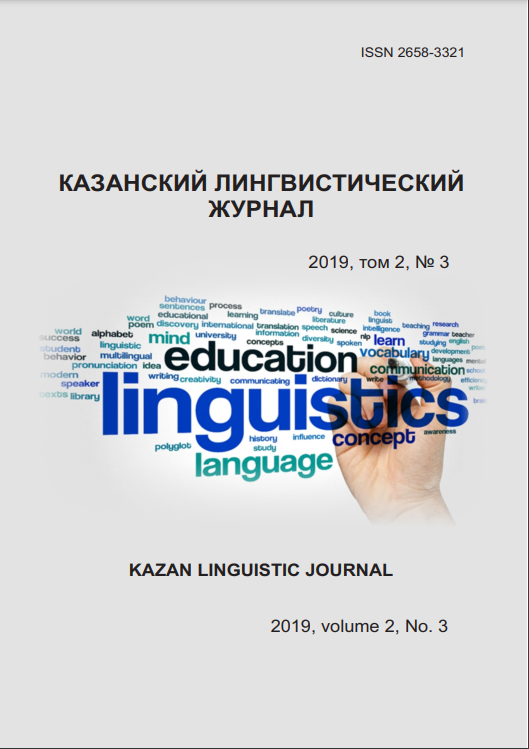Analysis of Xu Shen radical system in the works of modern researchers
Keywords:
Chinese language, key system, characters, radicals, Xu Shen, Showen JieziAbstract
Chinese writing has a close link with the culture of this country, which had an important impact on the evolution of the language. Radicals are basic symbol elements of Chinese writing, which have a special significance and meaning, but despite the fact that hieroglyphic radicals (keys) play a crucial role in mastering Chinese writing and their etymology allows us to trace the evolution of the development of hieroglyphic characters, this topic has been little studied in Russian synology In this connection, it is of a particular interest to modern researchers. Xu Shen was the first to create a system of classification Chinese characters by using basic graphic elements. This article describes some aspects of the modern analysis of the radical system of Chinese writing, presented by Chinese authors. This article presents a modern analysis of the first key system consists of 540 symbols created by Xu Sheng during the systematization of hieroglyphs in the dictionary "Showen jiezi", as well as data on options about reducing the number of radicals. The materials of this research can be used in further etymological and cultural studies, as historical changes in the elements of Chinese writing reflects the general socio-cultural changes in Chinese society.
References
Литература
Крюков М.В., Переломов Л.С., Софронов М.В., Чебоксаров Н.Н. Древние китайцы в эпоху централизованных империй. // М.: 1983. С. 299
Чжай Хуанюнь. К вопросу преподавания китайского языка с точки зрения отражения в нем традиции и культуры Китая // Иностранные языки в высшей школе. 2013. №2 (25). - С. 88-90.
Шовэнь цзецзы (Электронный словарь) // URL :http://www.cidianwang.com/shuowenjiezi/. (Дата обращения 20.01.2019)
Ebrey, Patricia Buckley. 1999. The Cambridge Illustrated History of China. Cambridge: Cambridge University Press. ISBN 0-521-66991-X. Р. 123
Françoise Bottéro and Christoph Harbsmeier: The Shuowen Jiezi Dictionary and the Human Sciences in China // URL: https://www2.ihp.sinica.edu.tw/file/1417mhJqrUR.pdf (Дата обращения: 18.01.19)
He Hu , Xiaoyong Du , Xuan Tian, Ruixue Bai: A Preliminary Study on the Semantic Strength of Chinese Radicals // URL: http://ieeexplore.ieee.org/stamp/stamp.jsp?arnumber=4406158
(Дата обращения: 18.01.19)
He Xu, Che-Ren Huang: An Analysis of Radicals-based Features in Subjectivity Classification on Simplified Chinese Sentences // URL: http://aclweb.org/anthology/Y14-1057 (Дата обращения: 03.01.2019)
洪凌雯汉字结构的分析和归类中国文字研究与应用中心, 上海 // URL: https://www.sinoss.net/qikan/uploadfile/2010/1130/788.pdf (Дата обращения: 03.01.2019)
王宁.汉字构形学讲座 [M].上海:上海教育出版社,2002. 58.
杨 玲 : 《说文解字》无属字部首的分类、特点分析及探因 //URL: http://www.ffl.kanagawa-u.ac.jp/graduate/ronsyu/img/vol_21/vol21_07.pdf,
(Дата обращения 18.01.2019)
李晓明: 术语不统一带来混乱 科技名词期待规范与创新 // URL: http://news.sciencenet.cn/htmlnews/2008228807391202289.html (Дата обращения: 15.12.2018)
References
Kriukov, M.V., Perelomov, L.S., Sofronov, M.V., Cheboksarov, N.N. (1983). Drevnie kitaitsy v epokhu tsentralizovannykh imperii [The ancient Chinese in the era of centralized empires]. Moscow. 299 p. (In Russian)
Chzhai Khuaniun'. K voprosu prepodavaniia kitaiskogo iazyka s tochki zreniia otrazheniia v nem traditsii i kul'tury Kitaia [To the question of teaching Chinese from the point of view of reflecting in it the tradition and culture of China] // Inostrannye iazyki v vysshei shkole. 2013. №2 (25). S. 88-90. (In Russian)
Shuowen Jiezi (E-dictionary) // URL :http://www.cidianwang.com/shuowenjiezi/ (accessed: 20.01.2019). (In Chinese)
Ebrey, Patricia Buckley (1999). The Cambridge Illustrated History of China. Cambridge: Cambridge University Press. ISBN 0-521-66991-X. Р. 123. (In English)
Françoise Bottéro and Christoph Harbsmeier. The Shuowen Jiezi Dictionary and the Human Sciences in China // URL: https://www2.ihp.sinica.edu.tw/file/1417mhJqrUR.pdf (accessed 18.01.19). (In English)
He Hu , Xiaoyong Du , Xuan Tian, Ruixue Bai: A Preliminary Study on the Semantic Strength of Chinese Radicals // URL: http://ieeexplore.ieee.org/stamp/stamp.jsp?arnumber=4406158 (accessed: 18.01.19). (In Chinese)
He Xu, Che-Ren Huang: An Analysis of Radicals-based Features in Subjectivity Classification on Simplified Chinese Sentences // URL: http://aclweb.org/anthology/Y14-1057 (accessed: 03.01.2019). (In Chinese)
洪凌雯汉字结构的分析和归类中国文字研究与应用中心, 上海URL: https://www.sinoss.net/qikan/uploadfile/2010/1130/788.pdf (accessed 03.01.2019). (In Chinese)
王宁.汉字构形学讲座 .上海:上海教育出版社,2002. 58. (In Chinese)
杨 玲 : 《说文解字》无属字部首的分类、特点分析及探因 // URL: http://www.ffl.kanagawa-u.ac.jp/graduate/ronsyu/img/vol_21/vol21_07.pdf, (accessed:18.01.2019 ). (In Chinese)
李晓明: 术语不统一带来混乱 科技名词期待规范与创新 // URL: http://news.sciencenet.cn/htmlnews/2008228807391202289.html (accessed: 15.01.2019). (In Chinese)






